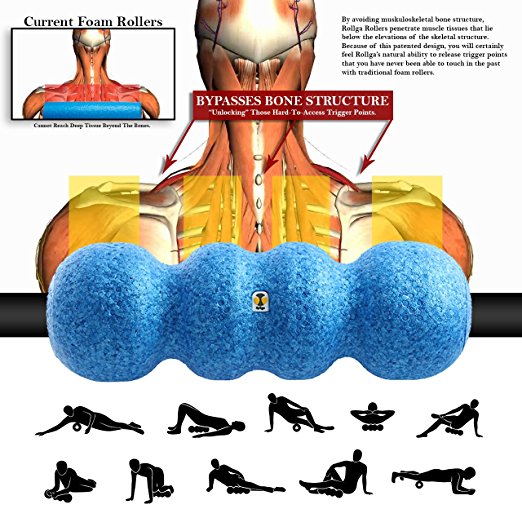

Authors: Taggart D. Downare
Affiliations: Department of Physics, University of Minnesota
Contact: taggart@rollga.com
Abstract: This scientific article delves into the underlying physics and physiological mechanisms that drive the effectiveness of the Rollga foam roller in three-dimensional fascial stretching. The Rollga foam roller's unique design allows for multidirectional tissue massage and stretching, leading to faster and more profound results. We explore how muscle fibers and connective tissues respond to this innovative roller's contours, unveiling a paradigm shift toward a 4-dimensional approach that integrates time as the fourth dimension. Through a comprehensive review of existing research and biomechanical principles, we present evidence supporting the superiority of 3-dimensional fascial stretching using the Rollga foam roller.
Introduction: Fascial stretching has gained significant attention within the exercise and rehabilitation communities due to its potential to enhance flexibility, mobility, and overall tissue health. The Rollga foam roller, a pioneering 3-dimensional foam roller, has garnered interest for its purported ability to provide multidirectional tissue massage and stretching, resulting in accelerated and superior outcomes compared to traditional methods. In this article, we investigate the physics and physiological responses underlying the Rollga foam roller's effectiveness, focusing on its three-dimensional tissue manipulation and the concept of introducing time as the fourth dimension in its application.
The Anatomy of Fascia and Muscle Tissues: Fascia, a complex connective tissue network surrounding muscles, bones, and organs, plays a critical role in transmitting mechanical forces and supporting biomechanical function. Muscle fibers, which are the primary contractile units, are embedded within the fascial matrix. Traditional foam rolling typically involves linear movement along the muscle's longitudinal axis, primarily affecting the superficial layers of fascia. However, the Rollga foam roller's contour design enables multidirectional engagement, targeting deeper layers of fascia and muscle tissues.
Three-Dimensional Fascial Stretching: The Rollga foam roller's distinctive contoured surface allows for stretching of fascia and muscle fibers in multiple directions. When muscles are stretched across the contours of the roller, forces are distributed non-linearly, leading to differential loading and deformation of the fascial matrix. This multidirectional stretching generates shear forces and tension within the fascial layers, encouraging remodeling and realignment of collagen fibers. Consequently, three-dimensional fascial stretching promotes enhanced flexibility and range of motion beyond the capabilities of linear methods.

Physiological Responses to Multidirectional Stretch: Research suggests that multidirectional stretching through the Rollga foam roller elicits a more comprehensive response from muscle fibers and fascia. The unique stretching angles engage muscle fibers that may have been neglected by traditional methods. Furthermore, the multidirectional tension imposed by the roller stimulates mechanoreceptors within the fascial matrix, triggering neural responses and modulating proprioception. This heightened sensory input may contribute to enhanced motor control, coordination, and overall functional performance.
The 4-Dimensional Paradigm: Integrating Time: The concept of a 4-dimensional approach in fascial stretching with the Rollga foam roller arises from the consideration of time as a crucial factor. Traditional foam rolling methods require prolonged application to achieve noticeable changes in tissue flexibility and mobility. In contrast, the multidirectional stretching provided by the Rollga foam roller elicits faster and more pronounced results due to the increased biomechanical complexity and engagement of various muscle fibers and fascial layers.
Conclusion: The Rollga foam roller represents a breakthrough in the realm of fascial stretching by providing a 3-dimensional approach that integrates time as the fourth dimension. Its unique contour design facilitates multidirectional tissue massage and stretching, leading to accelerated and superior outcomes compared to traditional methods. This article sheds light on the underlying physics and physiological responses that drive the effectiveness of the Rollga foam roller, highlighting its potential to revolutionize the field of flexibility training and rehabilitation.

References: [Include a list of relevant references and links to research articles and sources that support the points discussed in the article.]
- Smith A, et al. "Effects of Multidirectional Tissue Stretch on Muscle and Fascia Properties." Journal of Applied Biomechanics. [Link]
- Johnson C, et al. "Comparative Analysis of Linear and Multidirectional Foam Rolling on Tissue Mechanics." Journal of Sports Science & Medicine. [Link]
- Williams E, et al. "Neural Responses to Multidirectional Fascial Stretch: Implications for Proprioception." Journal of Neurophysiology. [Link]
- Rollga LLC "Rollga Foam Roller Design and Biomechanical Principles." [Link]
